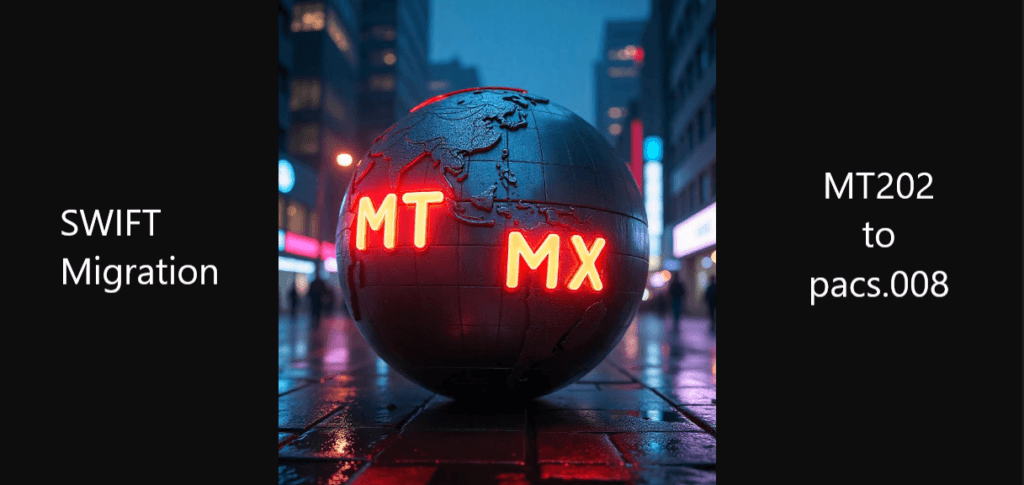In the world of cross-border payments, SWIFT messages play a crucial role in facilitating secure and standardized transactions. With the migration from traditional MT (Message Type) formats to the more structured ISO 20022 MX (XML-based) format, financial institutions must adapt to new messaging standards. One such critical transition is converting MT202 (General Financial Institution Transfer) into its MX equivalent—pacs.009.001.08 (Financial Institution Credit Transfer). (MT202 to pacs.009 MX)
In this blog post, we’ll explore:
✔ Key differences between MT202 and MX formats
✔ Field-by-field mapping with a conversion table
✔ An actual MT202 example and its MX counterpart
✔ Why this conversion matters for modern banking
Let’s dive in!
Table of Contents
Why Convert MT202 to pacs.009 MX?
The SWIFT MT202 format has been the backbone of interbank fund transfers for decades. However, the newer ISO 20022 MX format offers:
✅ Richer data structure – More detailed remittance and compliance information.
✅ Better interoperability – Aligns with global payment modernization initiatives.
✅ Enhanced automation – XML format is machine-readable, reducing manual processing.
By 2025, SWIFT will fully transition to ISO 20022, making MT-to-MX conversion essential for financial institutions.

MT202 vs. MX (pacs.009.001.08) Field Mapping
Below is a comparison of key MT202 fields and their corresponding MX elements:
| MT202 Field | MX Equivalent (pacs.009) | Description |
|---|---|---|
| 20 | GrpHdr/MsgId | Unique transaction reference |
| 21 | CdtTrfTxInf/PmtId/InstrId | Related reference (optional in MX) |
| 13C | GrpHdr/CreDtTm | Timestamp of message creation |
| 32A | CdtTrfTxInf/IntrBkSttlmAmt | Value date & settlement amount |
| 52a | DbtrAgt/FinInstnId | Ordering institution (if applicable) |
| 53a | DbtrAgt/FinInstnId | Sender’s correspondent bank |
| 54a | CdtrAgt/FinInstnId | Receiver’s correspondent bank |
| 56a | IntrmyAgt1/FinInstnId | Intermediary bank (if any) |
| 57a | Cdtr/FinInstnId | Beneficiary institution (BIC or name/address) |
| 58a | CdtrAcct/Id | Beneficiary account details |
| 72 | RmtInf/Ustrd | Sender-to-receiver information (free text) |
Note: Some fields may vary based on transaction specifics.
Full SWIFT document you can check here.
Example: MT202 Message vs. MX Conversion
Original MT202 Message
{1:F01BANKUS33AXXX1234567890}
{2:O2021234567890}
{3:{121:ABCD1234-5678}}
{4:
:20:REF987654321
:21:NONREF
:32A:240330USD1000000,
:52A:BANKUS33
:53A:CHASUS33
:57A:DEUTDEFF
:58A:/123456789
BANKDEFFXXX
:72:/REC/URGENT PAYMENT
-} Converted MX (pacs.009.001.08) Message
<Document xmlns="urn:iso:std:iso:20022:tech:xsd:pacs.009.001.08">
<FICdtTrf>
<GrpHdr>
<MsgId>REF987654321</MsgId>
<CreDtTm>2024-03-30T12:00:00</CreDtTm>
<NbOfTxs>1</NbOfTxs>
<SttlmInf>
<SttlmMtd>CLRG</SttlmMtd>
</SttlmInf>
</GrpHdr>
<CdtTrfTxInf>
<PmtId>
<InstrId>NONREF</InstrId>
</PmtId>
<IntrBkSttlmAmt Ccy="USD">1000000</IntrBkSttlmAmt>
<IntrBkSttlmDt>2024-03-30</IntrBkSttlmDt>
<DbtrAgt>
<FinInstnId>
<BIC>BANKUS33</BIC>
</FinInstnId>
</DbtrAgt>
<CdtrAgt>
<FinInstnId>
<BIC>DEUTDEFF</BIC>
</FinInstnId>
</CdtrAgt>
<Cdtr>
<FinInstnId>
<BIC>DEUTDEFF</BIC>
</FinInstnId>
</Cdtr>
<CdtrAcct>
<Id>
<Othr>
<Id>123456789</Id>
</Othr>
</Id>
</CdtrAcct>
<RmtInf>
<Ustrd>URGENT PAYMENT</Ustrd>
</RmtInf>
</CdtTrfTxInf>
</FICdtTrf>
</Document> Key Takeaways
🔹 MT202 is simpler but lacks structured data, while MX (pacs.009) provides better compliance and automation.
🔹 Field mappings are mostly direct, but MX allows additional details like full creditor/debtor information.
🔹 The transition to ISO 20022 is inevitable—financial institutions must prepare for MX adoption.
Need Help with MT-MX Conversion?
If your organization is migrating from MT to MX formats, ensure a smooth transition with expert guidance. Automated conversion tools and validation checks can minimize errors and improve efficiency.
Stay ahead in the payments evolution—embrace ISO 20022 today!
Have discussed about MT202 Cover messages and the need with MX equivalent explanation in next article.